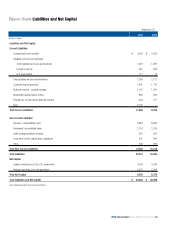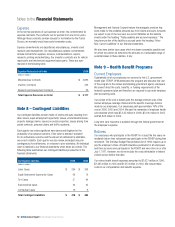US Postal Service 2006 Annual Report Download - page 50
Download and view the complete annual report
Please find page 50 of the 2006 US Postal Service annual report below. You can navigate through the pages in the report by either clicking on the pages listed below, or by using the keyword search tool below to find specific information within the annual report.48 | 2006 Annual Report United States Postal Service
Note 1 – Description of Business
Nature of Operations
The United States Postal Service provides mail service to the public,
offering a variety of classes of mail services without undue discrimination
among our many customers. This means that within each class of mail our
price does not unreasonably vary by customer for the levels of service we
provide. This fulfills our legal mandate to offer universal service at a fair
price. We conduct our operations primarily in the domestic market, with
international operations representing less than 3% of our total revenue.
Our primary lines of service are First-Class Mail, Priority Mail, Express
Mail, Periodicals Mail, Standard Mail, Package Services and International
Mail. The principal markets for these services are the communications,
distribution, delivery, advertising and retail markets. Our services
(products) are sold and distributed through almost 37,000 Post Offices,
stations, branches, contract postal units, a large network of consignees,
more than 600 processing facilities and almost 1,000 administrative and
support facilities.
Our labor force is primarily represented by the American Postal Workers
Union, National Association of Letter Carriers, National Postal Mail
Handlers Union and National Rural Letter Carriers Association. More
than 85% of our career employees are covered by collective bargaining
agreements. The agreements with the major unions expire November
20, 2006. Information on labor agreements can be found on our website
www.USPS.com.
By law, we also consult with management organizations representing most
of the employees not covered by collective bargaining agreements. These
consultations provide an opportunity to participate directly in the planning,
development, and implementation of programs and policies affecting
the managerial employees in the field. The management organizations
include the National Association of Postal Supervisors, National League of
Postmasters and National Association of Postmasters of the United States.
Postal Reorganization
We commenced operations on July 1, 1971, in accordance with the provi-
sions of the Postal Reorganization Act (the Act). We are an “independent
establishment” of the executive branch of the U.S. government. Governing
decisions are made by a Board of Governors appointed by the President
with the advice and consent of the Senate.
The equity that the U.S. government held in the former Post Office
Department became our initial capital. We valued the assets of the former
Post Office Department at original cost less accumulated depreciation.
The initial transfer of assets, including property, equipment and cash,
totaled $1.7 billion. Subsequent cash contributions and transfers of assets
between 1972 and 1982 totaled approximately $1.3 billion, resulting in
total government contributions of $3.034 billion. The U.S. government
remains responsible for all the liabilities attributable to operations of the
former Post Office Department, however, under the Balanced Budget Act
of 1997, the liability for Post Office Department workers’ compensation
costs was transferred to us.
We enter into significant transactions with other government agencies, as
disclosed throughout these financial statements.
Price Setting Process
Since 1971, the Act has required us to establish prices that cover the
costs of operating the postal system. The ratemaking process provides for
the recovery of financial losses through future rate increases.
The Act established the independent Postal Rate Commission (PRC) with
oversight responsibility for recommending fair and equitable rates of post-
age and fees, subject to approval by the Governors of the Postal Service.
Note 2 – Summary of Significant
Accounting Policies
Basis of Accounting and Use of Estimates
We conform to accounting principles generally accepted in the United
States. We maintain our accounting records and prepare our financial
statements on the accrual basis of accounting. Following these principles,
we make estimates and assumptions that affect the amounts we report
in the financial statements and notes. Actual results may differ from our
estimates.
Segment Information
We operate in one segment throughout the United States, it possessions,
territories and internationally.
Reclassifications
Certain comparative prior year amounts in the financial statements and
accompanying notes have been reclassified to conform to the current year
presentation. These reclassifications had no effect on previously reported
operating income and net income.
We currently recognize checks outstanding as a reduction of cash. We
previously recognized checks outstanding as a current liability until
presented for payment. Due to this 2006 change in accounting policy
we have reclassified our balance sheets and statements of cash flow
as required by Generally Accepted Accounting Principles (GAAP). This
reclassification had no effect on our previously reported net income.
Cash and Cash Equivalents
We consider securities that mature within 90 days or less from the date
we buy them as cash equivalents.
Notes to the Financial Statements
























